Ukrainka Lesja 25.2.1871 - 1.8.1913
Njeno pravo ime je Larisa Kosač in
je najpomembnejša ukrajinska pesnica predstavnica ukrajinske moderne. Pisala je pesmi in drame, pogosto z biblično tematiko.
Lesja Ukrainka is pseudonym of Larisa Kosach the most important ukrainian poet. She wrote poetry and dramas, many with biblical themes.
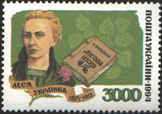
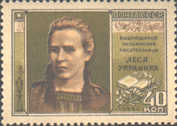
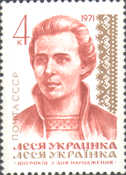
UA - 136
SU - 1870
SU
- 3855
ULANOVA Galina Sergejevna
8.1.1910 - 21.3.1998
Ruska plesalka in pedagoginja je bila dvakrat
odlikovana z redom junaka socialističnega dela (1974, 1980). Leta 1951 pa je
bila proglašena za Ljudska umetnika SZ. Diplomirala je na koreografski šoli
v Leningradu in bila v letih 1928 – 1941 solistka v operi Kirov. Odplesala
je številne glavne vloge: Odette, Giselle in druge. Nagrajena je bila s
Stalinovo nagrado (1941, 1946, 1947, 1950) in Leninovo nagrado (1957).
Na znamki RU-857 je prizor iz baleta Romeo in Julija (1940), kjer je
Ulanova plesala kot Julija in K.M.Sergeyev kot Romeo.
She was dancer, pedagogue,
Hero of Socialist Labor (1974, 1980), People"s Artist of the USSR (1951).
Graduating from the Leningrad Choreographic School under A.Y. Vaganova, she
was a soloist at the Kirov Opera and Ballet Theatre from 1928 until 1941.
She was the first to play the role of Maria in The Fountain of
Bakhchisaray (1934, ballet master R.V. Zakharov) and Juliet (1940,
ballet master L.M. Lavrovsky). She also played Odette/Odile, Giselle, and
other major roles. Ulanov" roles were characterised by an extraordinary
harmony of dancing, imparting grace to simple movements and naturalness to
complex ones. Through her art she made real the tender poetic heroines who
lived in love and defended love at the expense of their lives. Tragic
finales became light and hopeful when Ulanova played them. A bronze bust
modelled after her was installed in Moscow Podeby Park (1984, sculptor M.K.
Anikushin). She was awarded the Stalin Prize (1941, 1946, 1947, 1950) and
Lenin Prize (1957).
The stamp
RU-857
features
a her portrait and a fragment from Prokofiev's Romeo and Juliet ballet
(1940), where Ulanova danced as Juliet, and K.M.Sergeyev danced as Romeo.
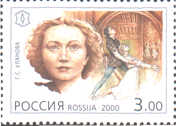
RU - 857
ULJANOV Marija Aleksandrovna 1835 - 1916
Bila je mati Vladimirja Lenina, boljševiškega
revolucionarnega šefa policije in ustanovitelje ZSSR. Njen oče je bil
Aleksander Blank, bogat zdravnik, njena mati Anna Ivanovna Groschopf pa hči
nemškega očeta Johanna Groschopfa. Uljanova se je šolala doma. Študirala je
nemščino, francoščino in angleščino, pa tudi ruščino in zahodno literaturo.
Leta 1863 je maturirala in postala učiteljica za osnovno šolo. Vendar je
večino svojega življenja skrbela za svoje otroke. Potem ko se je poročila z
Ilyjo Nikolajevičem Uljanovom, učiteljem matematike in fizike, je par živel
v Penzi. Kasneje so se preselili v Nižni Novgorod in še kasneje v Simbirsk,
kjer je Uljanov prevzel prestižno mesto inšpektorja osnovnih šol. Dvakrat je
potovala v tujino, da bi srečala sina Vladimirja Lenina: v Francijo poleti
1902 in v Stockholm jeseni 1910.
She was the mother of Vladimir Lenin, the Bolshevik
revolutionary police chief and founder of the USSR. Her father was Alexander
Blank, a wealthy physician. Her mother, Anna Ivanovna Groschopf, was the
daughter of a German father, Johann Groschopf. Uljanova was a homeschooler,
and studied German, French, and English as well as Russian and Western
literature. In 1863, she graduated and became a primary school teacher.
However, she will spend most of her life caring for her children. After
marrying Ilya Nikolaevich Ulyanov, a teacher of mathematics and physics, the
couple settled in moderate prosperity in Penza. Later, he was transferred to
Nizhny Novgorod and later to Simbirsk, where Ulyanov took a prestigious
position as inspector of primary schools. She traveled abroad twice to meet
her son Vladimir Lenin (in France in the summer of 1902 and in Stockholm in
the fall of 1910).
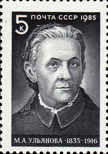
SU - 5474
Uljanova
Marija Iljinična
1878 - 1937
Leninov najmlajša sestra ena vodilnih
osebnost komunistične partije Sovjetske zveze se je revolucionarnemu gibanju
pridružila še ko je bila študent. Kot članica boljševikov je delovala v
Sankt Peterburgu, Moskvi, Saratovu in v drugih mestih v Rusiji in v tujini.
Leta 1900 je začela delati za časopis Iskra. Zaradi svoje revolucionarne
aktivnosti je bila večkrat aretirana in izgnana. Od 1917 do 1929 je bila
članica uredništva časopisa Pravda in njen izvršni sekretar. Bila je članica
moskovskega sovjeta. Leta 1935 je bila izvoljena v centralni izvršnega
odbora Sovjetske zveze.
She was a leading figure in
the Communist Party and public affairs; Lenin’s youngest sister. She joined
the revolutionary movement while still a student, became a professional
revolutionary in 1898 and was later among the Bolsheviks; she did Party work
in St. Petersburg, Moscow, Saratov and in other towns in Russia and abroad.
In 1900 she began taking an active part in the work of the newspaper
Iskra (The Spark) and from the autumn of 1903 was in the secretariat of
the C.C. of the Party. In 1904 she worked in the St. Petersburg Bolshevik
organisation. She was arrested and exiled several times for her
revolutionary activities. From March 1917 to the spring of 1929 she was a
member of the Pravda editorial board and the executive secretary of the
paper. She became a member of the Central Control Commission at the 14th
Party Congress and a member of the Soviet Control Commission at the 17th
Party Congress. She was a member of the Moscow Soviet and in 1935 was
elected to the Central Executive Committee of the U.S.S.R.
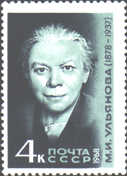
SU - 3463
ULLMANN Liv
16.12.1938 -
Norveška filmska igralka je najbolj znana po filmih v režiji Ingmarja
Bergmana: Persona (1966), Shame (1968), Cries and Whispers (1972), Scenes
from a Marriage (1974), Face to Face (1976), Autumn Sonata (1978), in Jan
Troell's The Emigrants (1972). Nastopala je v New Yorku v 70-tih in 80-tih
letih kjer je režirala film Sofie (1993). Napisala je dve avtobiografski
deli: Changing (1977) and Choices (1984).
Na znamki S -3232 je tudi
Andersson Bibbi.
A Norwegian actress, Liv Ullmann, is best known for the films she has made with Ingmar Bergman. Most striking in
Persona (1966), she has also given fine performances in Shame (1968),
Cries and Whispers (1972), Scenes from a Marriage (1974), Face to
Face (1976), Autumn Sonata (1978), and in Jan Troell's The Emigrants (1972). She appeared on the New York stage in the 1970s and '80s. She also cowrote and directed the film
Sofie (1993). Her autobiographical writings include Changing (1977) and
Choices (1984).
On stamp
S -3232
is also
Andersson Bibbi.
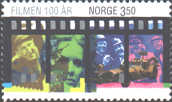

N -
1215
S -3232
Under Marie
27.3.1883 - 25.9.1980
Smatrajo za največjo estonsko pesnico 20.
stoletja. Leta 1944 je pred sovjetsko okupacijo pobegnila na Švedsko kjer je
živela v izgnanstvu do smrti. Prvo svojo pesem je objavi pri 21. letih v
časopisu Postimees.
Estonian poet, generally
considered among the greatest poets of the 20th-century in her language.
Under escaped with her family in 1944 the Soviet occupation of Estonia to
Sweden, where she spent in exile the rest of her life. Under's works have
been translated into some ten languages. Under's first poem appeared in the
newspaper Postimees when she was 21.
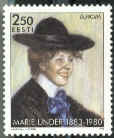
EE - 279
Undset Sigrid
20.5.1882 - 8.6.1949
Slavna norveški pisateljica je mednarodno znana po svojih zgodovinskih
romanih. Leta 1928 je prejela Nobelovo nagrado za literaturo. Njeni prvi
romani Fru Marta Oulie (1907), Penny (1911) in Images in a Mirror (1917)
obravnavajo vlogo sodobne ženske na Norveškem. Njena zgodovinska trilogija
Kristin Lavransdatter (1920-1922) velja za enega velikih del norveške
literature. Opisuje zmage in tragedije junakinje Kristin iz 14. stoletja od
otroštva do smrti zaradi kuge. Leta 1925 se je spreobrnila h katoliški veri
V zgodovinski tetralogiji Mojster Hestviken (1925-1927) postavljeni v
srednjeveško Norveško se ukvarja z verskimi vprašanji. Bila je zgodnji in
močan kritik nacizma. Pobegnila ja na Švedsko in od tam v ZDA. Na Norveško
se je vrnila po vojni.
A celebrated Norwegian novelist, Sigrid Undset, gained international fame as the author of historical novels and in 1928 received the Nobel Prize for literature. Although her father, an archaeologist, had introduced her to Norwegian medieval history at an early age, her first novels were set in contemporary Norway.
Fru Marta Oulie (1907), Jenny (1911 ), and Images in a Mirror (1917) all deal with the role of modern women, caught between traditional duties and a new need for freedom. The historical trilogy
Kristin Lavransdatter (1920-22) ranks as one of the great works of Norwegian literature. It portrays the triumphs and tragedies of its protagonist, Kristin, from age seven to her death in the plague 40 years later. Set in 14th-century Norway, the trilogy offers a penetrating analysis of a woman's development from childhood to maturity and a picture of the life and culture of medieval Norway. Undset converted to Catholicism in 1925, and her next historical novel, the tetralogy
The Master of Hestviken (1925-27), also set in medieval Norway, shows her increasing preoccupation with religious questions. From the 1930s on, she dealt with more contemporary issues, expressing in her novels a concern for religious and racial tolerance. An early and forceful critic of Nazism, Undset fled to Sweden and then to the United States after the German invasion of Norway in 1940. She returned to Norway in 1945.
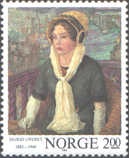
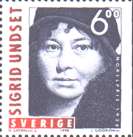
N - 871 S - 2083
TR - 997
URBANOVA Nevenka
28. 3. 1909 - 7. 1. 2007
Srbska igralka je bila članica
narodnega gledališča v Beogradu kjer je odigrala veš kot 150 vlog. Leta 1936
je dobila status Prvaka narodnega gledališča. Leta 1984 je dobila nagrado za
življensko delo - Dobričin prstan. Leta 2001 je objavila svoje spomine.
Serbian
actress. Already at the beginning of her career, critics competed to
describe her: eccentric temper, extravagant and refined appearance, Parisian
elegance and Slavic charm. To many, she looked like Hollywood actresses that
Belgrade was just discovering. “The most sex appealing actress of her time”
said Mata Milosevic, her frequent partner and close friend. She was adapting
stage eroticism to her romantic sensitivity, approaching a role with an open
heart and interpreting it intellectually. Nevenka was conquering the stage
with great elan. Her ruling over the stage couldn’t be set apart from the
powers of her body which, as an acting instrument was performing seductive
music.
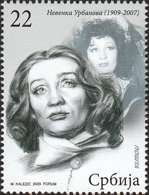
RS - 289
Utzon Lin
21.5.1946 -
Danska umetnica in
oblikovalka tekstila, oblikuje tudi porcelan. Za danski kraljevi balet je
kreirala scene in kostume. Za poslovne stavbe in cerkve je oblikovala
dekoracijo.
Lin Utzon is a textile designer and artist. Her work includes porcelain design, stage sets and costumes for the Royal Danish Ballet and decoration for architect Jørn Utzon's
(her father) church in Bagsværd, the Volvo corporate headquarters in Gothenburg, IBM in Dallas and San José, Tivoli Gardens in Denmark and Japan and the Capita Building in Sydney.
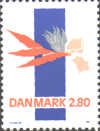
DK - 889
Uzvij Natalija
8.9.1898 -
30.7.1986
Ukrajinska igralka je nastopala v Ševčenkovem prvem gledališču v Ukrajini (1922-1925), v Državnem dramskem gledališču v Odesi, v Karkivskem dramskem gledališču in Kijevski drami. Nastopala je v različnih vlogah od herojskih do dramskih. V številnih dramah je odigrala vodilne ženske vloge. Od 1920 do 1940 je igrala tudi v številnih sovjetskih filmih.
Natalia Uzvij acted in the Shevchenko First Theatre of the Ukrainian Soviet Republic (1922-1925), for the Odesa State Drama Theatre, Kharkiv Drama Theatre and the Kyiv Ukrainian Drama Theatre. She played a wide range of roles - from heroic to dramatic. She also played the leading female character role in various dramas. She also starred in various Soviet films (1920s to 1940s).
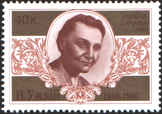
UA - 272
gor
- up |
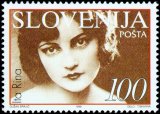 ZNAMENITE ŽENSKE NA ZNAMKAH
ZNAMENITE ŽENSKE NA ZNAMKAH